![]()
![]()
![]()
Use LEFT and RIGHT arrow keys to navigate between flashcards;
Use UP and DOWN arrow keys to flip the card;
H to show hint;
A reads text to speech;
46 Cards in this Set
- Front
- Back
- 3rd side (hint)
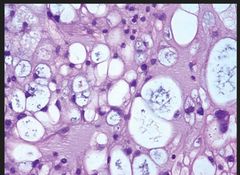
SAE08PA.67) The biopsy specimens seen in Figures 55a and 55b are from a lytic lesion in the sacrum of a 58-year-old man. What is the most likely diagnosis? 1Chondrosarcoma2Metastatic renal cell carcinoma3Chondromyxoid fibroma4Chordoma5Giant cell tumor |
4
The histology in this patient shows a lobulated lesion on low power with fibrous septae separating the lobules. At higher magnification, the cells have eosinophilic vacuolated cytoplasm and are called physaliferous cells |
|
|
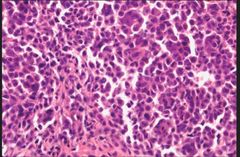
(SAE08PA.14) Figures 12a through 12e show the radiograph, MRI scans, and biopsy specimens of a 17-year-old boy. What is the most likely diagnosis? FIGURES: A B C D E 1Giant cell tumor2Chondroblastoma3Clear cell chondrosarcoma4Osteosarcoma5Tuberculous septic arthritis |
2 MRI scan shows extensive bone edema surrounding the lesion, consistent with chondroblastoma. Histology shows polygonal chondroblasts in a cobblestone-like pattern and areas of calcification consistent with chondroblastoma |
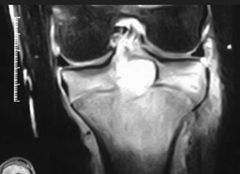
|
|
|
SAE08PA.45) A patient undergoes a simple excision of a 3-cm superficial mass in the thigh at another institution. The final pathology reveals a leiomyosarcoma, without reference to the margins. What is the recommendation for definitive treatment? Review TopicQID: 63061Repeat wide excision of the tumor bed2Observation3Radiation therapy to the tumor bed only4Chemotherapy5Radiation therapy and chemotherapy |
1 Treatment of patients with unplanned excision of soft-tissue sarcomas is challenging. If the margins are positive or unclear, the patient is best managed with repeat excision of the tumor bed, and radiation therapy if the repeat excision does not yield wide margins. In patients with no detectable tumor on physical examination or imaging after unplanned excision, some studies have shown that up to 35% of patients will have residual disease and a poorer local recurrence rate (22% versus 7%). Therefore, whenever feasible, a reexcision of the tumor bed is recommended. |
|
|
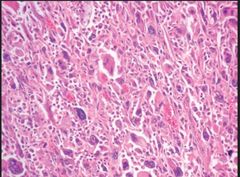
(SAE11PA.74) A 56-year-old woman has a 5-month history of a rapidly growing mass in the posteromedial aspect of the right leg. A clinical photograph, MRI scan, and biopsy specimen are shown in Figures 74a through 74c. What is the most appropriate treatment for this patient? 1Observation2Wide resection alone3Radiation therapy alone4Wide resection and radiation therapy5Debridement and antibiotics |
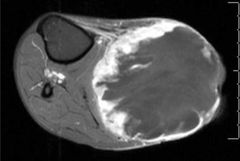
4 The clinical photograph shows an aggressive tumor growing through the skin (fungating). The axial T1-weighted MRI scan with contrast shows a large mass in the posterior and proximal leg with heterogeneous enhancement and a large nonenhancing center that suggests tumor necrosis, two poor prognostic factors in disease outcome. Finally, the histopathology suggests an undifferentiated pleomorphic spindle cell neoplasm. This is a high-grade sarcoma that requires both radiation therapy and wide excision to local disease control. The histopathology is characteristic of a high-grade sarcoma, not a local infection. The role of chemotherapy for most adult soft-tissue sarcomas remains controversial. |
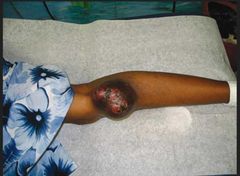
|
|
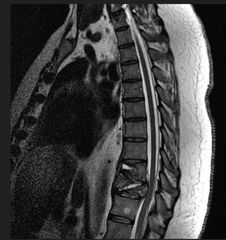
(SAE09SN.21) A 42-year-old man with a history of renal cell carcinoma has progressive weakness in the lower extremities for the past 3 weeks. The patient desires intervention. A sagittal T2-weighted MRI scan is shown in Figure 9a, and a sagittal contrast enhanced T1-weighted MRI scan is shown in Figure 9b. He currently ambulates minimal distances with a walker. His life expectancy is 8 months. Treatment of the spine lesion should consist of FIGURES: A B 1radiation therapy.2posterior laminectomy.3anterior corpectomy and reconstruction.4posterior laminectomy and fusion.5kyphoplasty. |

3 The MRI scans show a metastatic lesion in two contiguous vertebral bodies in the lower thoracic spine. Posterior laminectomy is not indicated because this does not adequately decompress the neural elements and will lead to progressive kyphosis. A posterior fusion may prevent progressive kyphosis but will not decompress the spinal cord. Renal cell carcinoma is not radiosensitive; therefore, radiation therapy would not be helpful in relieving neurologic compression. The lesion should be treated by an anterior corpectomy and reconstruction. This will allow for complete decompression as well as reconstruction of the anterior column. Kyphoplasty is not indicated in a lesion with disruption of the posterior cortex and neurologic impairment. |
|
|
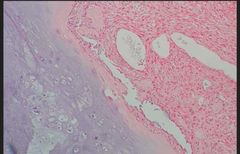
(SAE11PA.72) Figures 72a and 72b show the radiograph and biopsy specimen of a 92-year-old woman who reports increasing right shoulder pain. What is the most likely diagnosis? FIGURES: A B 1Enchondroma2Juxtacortical chondroma3Conventional chondrosarcoma4Dedifferentiated chondrosarcoma5Mesenchymal chondrosarcoma |
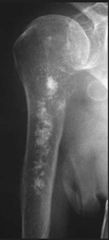
4 radiograph shows a lesion of the proximal humerus with stippled calcification suggestive of a cartilaginous neoplasm. The lesion has eroded through the cortex, and therefore, most likely represents a chondrosarcoma. The biopsy specimen reveals a high-grade spindle cell sarcoma adjacent to low-grade cartilage and is thus diagnostic of dedifferentiated chondrosarcoma. An enchondroma is a benign cartilaginous tumor contained entirely within the medullary cavity. A juxtacortical chondroma is a benign cartilage tumor on the surface of a bone. Conventional chondrosarcoma could present a radiographic appearance similar to this case; however, it would not contain a spindle cell component. Mesenchymal chondrosarcoma typically has small round blue cells and vascular proliferation with a hemangiopericytomatous pattern. |
|
|
|
(SAE08PA.80) What is the most common site of metastases from a soft-tissue sarcoma? 1Liver2Bone3Lymph nodes4Lungs5Muscle |
4 The most common site of metastases from a soft-tissue sarcoma is the lungs and occurs in 40% to 60% of patients. The second most common site of metastases in soft-tissue sarcomas is the lymph nodes. |
|
|

(SAE11PA.11) A 28-year-old woman has a painless mass on the dorsum of the foot that has been rapidly increasing in size over the last 3 months. It measures 5.7 cm in maximum diameter. A lateral radiograph of the foot is shown in Figure 11a. Sagittal T1-weighted and coronal T2-weighted MRI scans are shown in Figures 11b and 11c. A photomicrograph from the biopsy specimen is shown in Figure 11d. The most appropriate surgical treatment would likely include which of the following? FIGURES: A B C D 1Intralesional excision2Marginal excision and split-thickness skin grafting3Aspiration and antibiotics4Wide resection and flap coverage5Below-knee amputation |
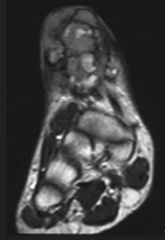
4 clinical presentation, imaging studies, and histology are consistent with a high-grade soft-tissue sarcoma. The MRI scans show a heterogeneous lesion. Histology demonstrates a spindle cell lesion with pleomorphism, atypica, and large bizarre mitoses. Treatment of soft-tissue sarcomas should include at least a wide resection. Intralesional or marginal excision is not advised for high-grade sarcoma. Below-knee amputation is an option for this patient, but most likely limb-sparing procedures for this particular sarcoma would be possible and also more functional while also allowing proper oncologic surgical resection. On this area of the dorsum of the foot, split-thickness skin grafting would likely have a higher failure rate than a fasciocutaneous flap over the tendons. Whereas aspiration of a fluid-containing cystic lesion (ganglion cyst) would be appropriate, it is not appropriate for this solid, heterogeneous lesion |

|
|
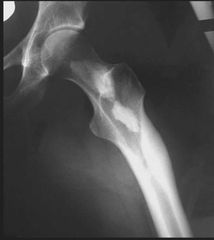
.(SAE08PA.78) A 21-year-old man is referred for evaluation of a lesion in the left proximal femur that was discovered when he was undergoing an upper gastrointestinal series. He reports no hip or thigh pain. Radiographs are shown in Figures 64a and 64b. What is the best course of action? Review TopicQID: 6339FIGURES: A B 1Observation2Needle biopsy3Incisional biopsy4Curettage5Wide resection |
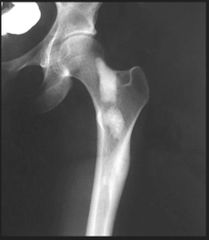
1 Melorheostosis is a rare disorder characterized by the classic radiographic appearance of flowing hyperostosis in a long bone. The hyperostosis may be on the periosteal or endosteal surface of the bone and frequently gives the appearance of wax falling down the side of a candle. The radiographs are diagnostic; therefore, no further work-up is indicated. |
|
|

(SAE11PA.9) A 7-year-old boy has a 3-week history of neck pain. History and physical examination reveal no neurologic symptoms. A radiograph, CT scan, and MRI scans are seen in Figures 9a through 9d. Figure 9e shows a needle biopsy specimen. Based on these findings, what is the most appropriate management? Review TopicQID: 7578FIGURES: A B C D E 1Cervical collar and observation2Intravenous antibiotics and cervical collar3Chemotherapy and radiation therapy4Neoadjuvant chemotherapy alone5Neoadjuvant chemotherapy and surgical resection (SAE11PA.9) A 7-year-old boy has a 3-week history of neck pain. History and physical examination reveal no neurologic symptoms. A radiograph, CT scan, and MRI scans are seen in Figures 9a through 9d. Figure 9e shows a needle biopsy specimen. Based on these findings, what is the most appropriate management? Review TopicQID: 7578FIGURES: A B C D E 1Cervical collar and observation2Intravenous antibiotics and cervical collar3Chemotherapy and radiation therapy4Neoadjuvant chemotherapy alone5Neoadjuvant chemotherapy and surgical resection |
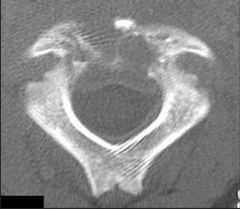
1 The findings are consistent with eosinophilic granuloma. Eosinophilic granuloma is a focal destructive lesion of bone commonly seen in children younger than age 10 years. Despite the very aggressive appearance of these lesions, they typically will heal spontaneously or following biopsy. Local corticosteroid injection has been advocated by some. Surgical decompression is indicated in rare cases of cord compression. Chemotherapy is indicated only in disseminated forms of histiocytosis. |
|
|
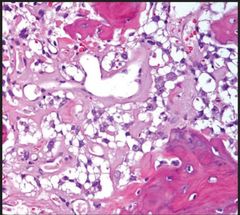
(SAE11PA.68) A 10-year-old boy has a 5-month history of pain in the left thigh and knee that has increased in severity such that he is currently unable to walk secondary to pain. He has a large fusiform swelling about the distal femur. A radiograph of both knees is shown in Figure 68a, and MRI scans are shown in Figures 68b through 68d. After complete staging, a biopsy is performed and a specimen is shown in Figure 68e. What is the most likely diagnosis? Review TopicQID: 7554FIGURES: A B C D E 1Osteomyelitis2Stress fracture3Osteoblastoma4Osteosarcoma5Ewing's sarcoma (SAE11PA.68) A 10-year-old boy has a 5-month history of pain in the left thigh and knee that has increased in severity such that he is currently unable to walk secondary to pain. He has a large fusiform swelling about the distal femur. A radiograph of both knees is shown in Figure 68a, and MRI scans are shown in Figures 68b through 68d. After complete staging, a biopsy is performed and a specimen is shown in Figure 68e. What is the most likely diagnosis? Review TopicQID: 7554FIGURES: A B C D E 1Osteomyelitis2Stress fracture3Osteoblastoma4Osteosarcoma5Ewing's sarcoma |
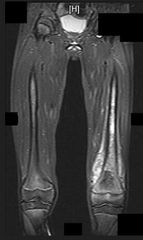
4 patient's clinical presentation is one of progressive pain. His radiographs show a destructive, bone-producing lesion that has extended outside the bone into the soft tissues. The pathology shows the production of osteoid by malignant spindle stromal cells. This is consistent with osteosarcoma. There is no inflammatory component of the histology to suggest osteomyelitis. Whereas osteoblastoma can be confused with osteosarcoma, the histology of malignant stromal cells as well as the radiographic findings are classic for osteosarcoma. Ewing's sarcoma can be associated with a significant soft-tissue mass, as seen in the MRI scan; however, histology would demonstrate a small blue round-cell tumor. |
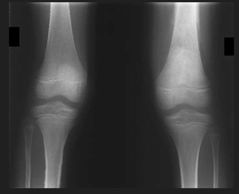
|
|

6NQDW6B6NQDW6B QUESTIONS12 of 50Previous NextReview and Submit (SAE11PA.15) A 28-year-old man has had left shoulder pain for 1 year. The pain is constant and has steadily worsened over time. History reveals that he underwent curettage for a "noncancerous bone tumor" 5 years ago. A radiograph, bone scan, MRI scan, and biopsy specimens are shown in Figures 15a through 15e. What is the most appropriate treatment for this patient? Review TopicQID: 7496FIGURES: A B C D E 1Wide resection alone2Resection and chemotherapy3Intralesional curettage and grafting4Forequarter amputation5Radiation therapy and prophylactic internal fixation |
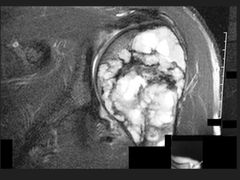
1 The radiographs and histology are consistent with a clear cell chondrosarcoma. The treatment is wide resection. No chemotherapy is indicated because this is a locally aggressive tumor with minimal risk of metastasis. Intralesional curettage may be appropriate for a benign bone tumor but not for a clear cell chondrosarcoma. Amputation and radiation therapy are not indicated to achieve local disease control. This case illustrates the occasional problems with diagnosis of this tumor. |
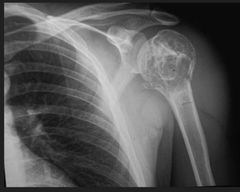
|
|
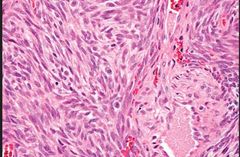
(SAE08PA.90) A 40-year-old man has a painless mass around his left ankle. He notes minimal growth over the past year. An MRI scan is shown in Figure 73a, and biopsy specimens are shown in Figures 73b and 73c. What is the most likely diagnosis? Review Topic 1Epithelioid sarcoma2Clear cell sarcoma3Pigmented villonodular synovitis4Malignant fibrous histiocytoma5Synovial sarcoma |
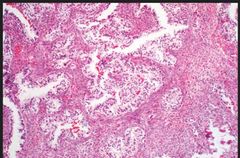
5 biopsy specimen is a low-power view of a soft-tissue sarcoma with a biphasic pattern of epithelial cells and fibrous spindle cells that are typical of a synovial sarcoma. A deep, painless soft-tissue mass greater than 5 cm in size is suspicious for a sarcoma |
|
|
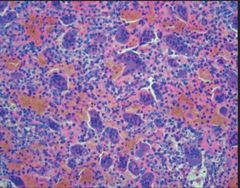
(SAE11PA.91) A 25-year-old man has had low back pain for the past 4 months. An AP pelvis radiograph, CT scan, MRI scan, and biopsy specimen are shown in Figures 91a through 91d. What is the most likely diagnosis? Review Topic 1Giant cell tumor2Chordoma3Osteosarcoma4Hemangioma5Rectal adenocarcinoma |

1 Imaging shows a lesion in the sacrum, with extension out of the bone. Histology shows multinucleated giant cells with deposits of hemosiderin. This is consistent with giant cell tumor. Chordoma commonly occurs in the sacrum as a midline lesion of notocord remnants, but the histology would show physaliferous cells. Osteosarcoma occasionally occurs in the sacrum, but histology would show malignant cells and osteoid. Hemangiomas in the spine are typically small, intraosseus lesions with vertical striations. Rectal adenocarcinoma would originate anterior to the sacrum and show a glandular pattern on biopsy |
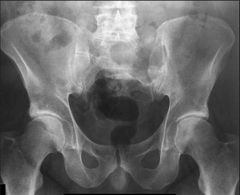
|
|
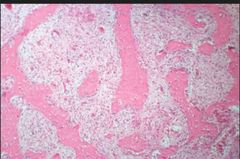
Onco 2RLJ2W6B QUESTIONS4 of 100Previous NextReview and Submit (SAE11PA.82) An 11-year-old boy has a 6-month history of groin pain and a limp. A radiograph is shown in Figure 82a and a biopsy specimen is shown in Figure 82b. What is the etiology of the lesion? Review TopicQID: 7570FIGURES: A B 1Viral infection2G(s) alpha mutation3t(11;22)4t(X;18)5Posttraumatic |

2 Fibrous dysplasia is a common benign skeletal lesion that may involve one bone (monostotic) or multiple bones (polyostotic) and occurs throughout the skeleton with a predilection for the long bones, ribs, and craniofacial bones. The etiology of fibrous dysplasia has been linked to an activating mutation in the gene that encodes the alpha subunit of stimulatory G protein (G(s)alpha) located at 20q13.2-13.3. The etiology for Paget's disease of bone is still unknown but growing evidence shows a possible link to a viral infection. t(11;22) is most commonly seen with Ewing's sarcoma and t(X;18) with synovial sarcoma |
|
|
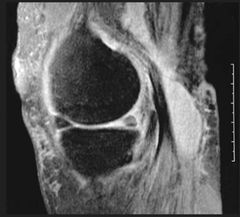
SAE08PA.37) An 80-year-old woman notes a painless mass posterior to her left knee. MRI scans are shown in Figures 31a and 31b. What is the best course of action? Review TopicQID: 6298FIGURES: A B 1Observation2Medical management3Needle biopsy4Incisional biopsy5Resection |
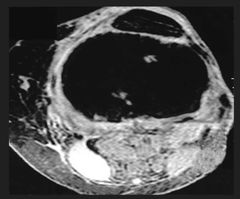
1 MRI scans show a popliteal cyst (Baker’s cyst) in its most common location. The cyst emerges from the knee joint between the medial head of the gastrocnemius muscle and the tendon of the semimembranosus muscle. These images are diagnostic; therefore, no further work-up is indicated. Since the patient is asymptomatic, no treatment is necessary. |
|
|
|
Onco 2RLJ2W6B QUESTIONS6 of 100Previous NextReview and Submit (SAE11PA.23) What syndrome is associated with the presence of enchondromas and hemangiomas? Review TopicQID: 75051Maffucci's syndrome2Hunter's syndrome3Multiple hereditary exostoses4Ollier's disease5Trevor's disease |
1 Maffucci's syndrome is characterized by the presence of enchondromas and hemangiomas. Ollier's disease is multiple enchondromatosis. Multiple hereditary exostoses is characterized by the presence of multiple exostoses not associated with skin lesions or endocrine abnormalities. Hunter's syndrome is a mucopolysaccharidosis and lysosomal storage disease that affects all large joints with pain and decreased range of motion. Trevor's disease is an epiphyseal osteochondroma |
|
|
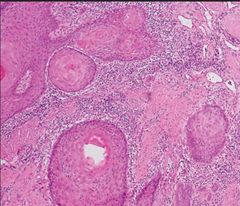
nco 2RLJ2W6B QUESTIONS7 of 100Previous NextReview and Submit (SAE10BS.25) A healthy 67-year-old man who sustained multiple fractures of the right lower extremity 30 years ago in a motor vehicle accident now has osteomyelitis of the calcaneus and resultant chronic draining sinuses on the heel pad. Figures 25a through 25c show the radiograph, T2-weighted MRI scan, and the biopsy specimen. What is the most appropriate management? Review TopicQID: 7113FIGURES: A B C 1IV antibiotics2Regional rotational flap3Split-thickness skin graft4Wide resection5Radiation therapy |
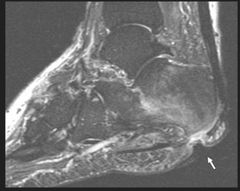
4 histology demonstrates squamous cell carcinoma, with characteristic squamous pearls with deep penetration of the tumor nests into the dense fascial tissue. These lesions are called Marjolin's ulcers. It is well known that malignant change can occur in the draining sinuses of patients with chronic osteomyelitis, and in the posttraumatic scars in these patients. There should be a high index of suspicion to biopsy sites of chronic drainage in these patients due to this complication. The incidence of this complication is reported to be approximately 1%. Many of these squamous cell lesions are low-grade. For the patient described in this question, IV antibiotics do not address the acquired malignancy, and the soft-tissue coverage procedures (rotation flap or skin grafts) address neither the chronic infection nor the malignancy. Radiation therapy is not appropriate in that it does not address the infection, and squamous cell carcinomas are not typically managed with radiation therapy. The preferred treatment is complete surgical excision, which may include amputation or wide resection with soft-tissue reconstruction. |
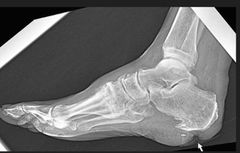
|
|
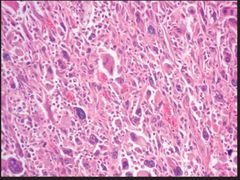
Onco 2RLJ2W6B QUESTIONS8 of 100Previous NextReview and Submit (SAE11PA.74) A 56-year-old woman has a 5-month history of a rapidly growing mass in the posteromedial aspect of the right leg. A clinical photograph, MRI scan, and biopsy specimen are shown in Figures 74a through 74c. What is the most appropriate treatment for this patient? Review TopicQID: 7561FIGURES: A B C 1Observation2Wide resection alone3Radiation therapy alone4Wide resection and radiation therapy5Debridement and antibiotics |

4
The clinical photograph shows an aggressive tumor growing through the skin (fungating). The axial T1-weighted MRI scan with contrast shows a large mass in the posterior and proximal leg with heterogeneous enhancement and a large nonenhancing center that suggests tumor necrosis, two poor prognostic factors in disease outcome. Finally, the histopathology suggests an undifferentiated pleomorphic spindle cell neoplasm. This is a high-grade sarcoma that requires both radiation therapy and wide excision to local disease control. The histopathology is characteristic of a high-grade sarcoma, not a local infection. The role of chemotherapy for most adult soft-tissue sarcomas remains controversial. |
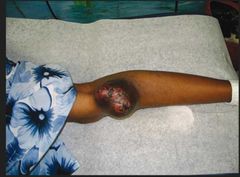
|
|
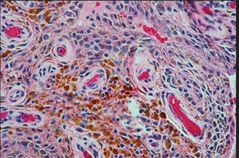
SAE11PA.80) An 18-year-old woman has pain and swelling in her lateral hindfoot. On examination, she has significant pain with resisted eversion of the foot. MRI scans are seen in Figures 80a (T1) and Figure 80b (non-fat T2), and a biopsy specimen is seen in Figure 80c. What is the most appropriate treatment for this patient? Review TopicQID: 7568FIGURES: A B C 1Marginal excision2Transtibial amputation3Injection of a radioisotope4Chemotherapy and radiation therapy5Wide local excision and radiation therapy |
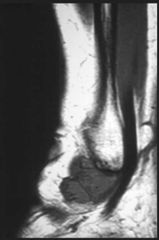
1 lesion has a stalk that originates in the subtalar joint, fills the sinus tarsi, and effaces the peroneal tendons. Soft-tissue masses that are periarticular should arouse suspicion for synovial sarcoma. Unlike synovial sarcoma however, this lesion was hypointense on both T1 and T2 MRI pulse-weighted sequences because of the large amounts of hemosiderin deposition, characteristic of pigmented villonodular synovitis. Furthermore, intra-articular synovial sarcomas are very rare. Radioisotopes are not very effective for pigmented villonodular synovitis in the foot and ankle because contiguous involvement of multiple joints is not uncommon. Furthermore, skin necrosis can occur with extravasation of radioisotope into the soft tissue. For this reason, complete (marginal) excision is recommended. For recurrent tumors, combined surgery and external beam irradiation has been advocated by some investigators. This is a benign tumor; therefore, aggressive surgical procedures (amputation and wide excision) are not appropriate. Radiation therapy may be a consideration in patients with recurrent and destructive disease |
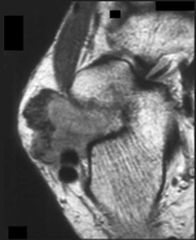
|
|
|
SAE08PA.80) What is the most common site of metastases from a soft-tissue sarcoma? Review TopicQID: 63411Liver2Bone3Lymph nodes4Lungs5Muscle |
4 most common site of metastases from a soft-tissue sarcoma is the lungs and occurs in 40% to 60% of patients. The second most common site of metastases in soft-tissue sarcomas is the lymph nodes. |
|
|
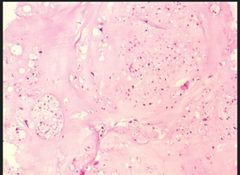
Onco 2RLJ2W6B QUESTIONS11 of 100Previous NextReview and Submit (SAE11OS.194) A 55-year-old woman has had a swollen and painful right knee for 1 year. Figures 194a and 194b show AP and lateral radiographs, and Figure 194c shows a biopsy specimen. What is the most likely diagnosis? Review TopicQID: 7782FIGURES: A B C 1Pigmented villonodular synovitis2Synovial chondromatosis3Septic arthritis4Loose bodies related to osteoarthritis5Chondroblastoma |
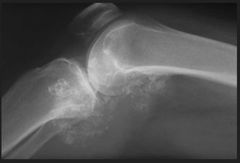
2 patient has synovial chondromatosis that is characterized by multiple calcified masses seen in the radiographs and by benign chondroid masses seen in the biopsy specimen. This is a benign condition that is typically treated by open, complete synovectomy of the joint. There have been rare cases reported of late conversion to chondrosarcoma, but most patients have good local control with synovectomy. Pigmented villonodular synovitis would not have mineralization and is characterized by recurrent bloody effusions and low-signal changes of gradient echo images on MRI. Loose bodies are usually much smaller, completely intra-articular, and can move around on examination. Septic arthritis is typically more acute in history and would not have cartilage formation on biopsy. Chondroblastoma is an osseous lesion and almost never has a soft-tissue extension. The biopsy specimen would show cobblestone chondroblasts with occasional giant cell-like osteoclasts |

|
|
|
nco 2RLJ2W6B QUESTIONS12 of 100Previous NextReview and Submit (SAE08PA.72) What is the most significant factor affecting long-term survival for a patient with bone sarcoma? Review TopicQID: 63331Presence of metastatic disease at presentation2Grade of tumor3Size of tumor4Depth of tumor invasion5Presence of necrosis |
1 |
|
|
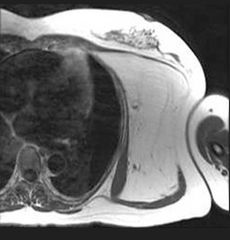
nco 2RLJ2W6B QUESTIONS13 of 100Previous NextReview and Submit (SAE11PA.17) An otherwise healthy 52-year-old man has had a several year history of a slowly enlarging, symptomatic left shoulder, axillary, and chest wall mass. Radiographs are only remarkable for a large soft-tissue mass. Selected sequences of MRI scans are shown in Figure 17a (T1), Figure 17b (T2 fat saturated), and Figure 17c (T1 fat saturated post-gadolinium). Management of this symptomatic mass should consist of which of the following? Review TopicQID: 7498FIGURES: A B C 1Forequarter amputation2Wide resection, chemotherapy, and radiation therapy3Wide resection and radiation therapy4Marginal excision5Incisional biopsy |

4 MRI scans show a large soft-tissue mass that is iso-intense with subcutaneous fat of all sequences. This is diagnostic of a lipocytic (fatty) tumor-either lipoma, atypical lipomatous tumor, or low-grade liposarcoma. As such, no biopsy is necessary because biopsies of these fatty tumors can be fraught with sampling error. The most appropriate treatment of this symptomatic lesion is simple, marginal excision without radiation therapy or chemotherapy. Local recurrence can occur in 25% to 50% of patients at 10 years. Dedifferentiation is rare with subsequent recurrent disease; but when it occurs, it may result in metastases. |
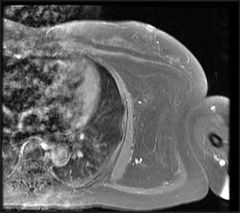
|
|
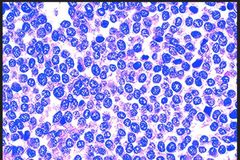
Onco 2RLJ2W6B QUESTIONS14 of 100Previous NextReview and Submit (SAE11PA.54) The radiographs, bone scan, and MRI scans of a 10-year-old girl are seen in Figures A through E. A biopsy specimen is seen in Figure F. Which of the following represents the treatment option with the best prognosis? Review TopicQID: 7539FIGURES: A B C D E F 1Wide resection without adjuvant2Methotrexate-based chemotherapy with radiation therapy3Methotrexate-based chemotherapy with wide resection4Vincristine, doxorubicin, cyclophosphamide, and dactinomycin-based chemotherapy with wide resection, with or without radiation therapy5Vincristine, doxorubicin, cyclophosphamide, and dactinomycin-based chemotherapy |
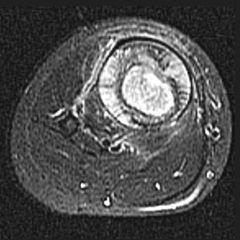
4 patient has Ewing's sarcoma. This tumor is best treated with neoadjuvant chemotherapy consisting of a regimen based around vincristine, doxorubicin, cyclophosphamide, and dactinomycin in combination with wide resection or amputation. Radiation therapy may have a role for local disease control with close surgical margins, surgically inaccessible sites, or in the presence of advanced disease. Osteosarcoma is treated with methotrexate-based chemotherapy and wide resection or amputation. |
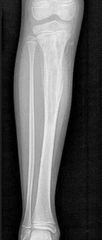
|
|
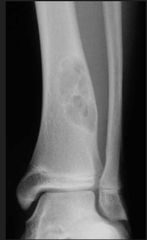
nco 2RLJ2W6B QUESTIONS15 of 100Previous NextReview and Submit (SAE11PA.75) An otherwise healthy 12-year-old boy has ankle pain after being kicked while playing soccer. Radiographs are shown in Figures 75a and 75b. Examination reveals tenderness to palpation, but not with weight bearing. He had no pain preceding the incident. What is the next most appropriate step in management? Review TopicQID: 7562FIGURES: A B 1Observation2Curettage and grafting3Wide surgical resection4Whole body bone scan5Chemotherapy |
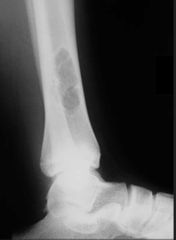
1 lesion shown is a nonossifying fibroma. With no pain preceding the traumatic episode and painless weight bearing, the lesion does not appear at risk for fracture. Simple observation with repeat radiographs at a time interval (3 to 6 months) to document stability is sufficient. Surgical intervention is unnecessary because the risk of fracture is low and the natural history is one of spontaneous regression during adolescence. The lesion is benign; therefore, chemotherapy is not indicated. While a bone scan may provide some useful information, it is unnecessary for the diagnosis and adds little to management decisions. |
|
|

Onco 2RLJ2W6B QUESTIONS16 of 100Previous NextReview and Submit (SAE10HK.46) Figure 46 shows the radiograph of a 65-year-old man who reports restricted range of motion and pain with sitting 18 months after undergoing right side revision total hip arthroplasty. What is the most appropriate management? Review TopicQID: 7034FIGURES: A 1Intensive physiotherapy2Alendronate3Indomethacin4Radiotherapy5Excision |
5 presence of Brooker grade 1 or 2 heterotopic ossification (HO) does not influence the outcome of total hip arthroplasty, whereas restricted range of motion and pain may occur in patients with more severe grade 3 or 4 HO. Treatment may be nonsurgical or surgical. Nonsurgical management includes intensive physiotherapy during the maturation phase of the disease in an attempt to limit the final stiffness. There appears to be no data regarding the effectiveness of this treatment. There is no role for NSAIDs or radiotherapy as a treatment for preexisting HO. Surgical treatment involves excision of the heterotopic bone and can be expected to improve the functional outcome. Bisphosphonates have been used in the past, but their use has been discontinued as they only postpone ossification until treatment is stopped. |
|
|
|
Onco 2RLJ2W6B QUESTIONS17 of 100Previous NextReview and Submit (SAE08PA.98) Which of the following is not a characteristic of synovial sarcomas? Review TopicQID: 63591may contain calcifications.2occur in younger patients than most soft-tissue sarcomas.3are usually intra-articular.4often respond well to chemotherapy.5often contain a known genetic abnormality |
3 Synovial sarcomas have a number of features that differentiate them from other soft-tissue sarcomas. They often have small areas of calcifications within the lesion. They occur in a younger patient population than most soft-tissue sarcomas. A subset of patients with synovial sarcoma tend to be chemosensitive. They often contain the SYT-SSX translocation. Although they can occur intra-articular, this is rare, despite their name. |
|
|
|
Onco 2RLJ2W6B QUESTIONS18 of 100Previous NextReview and Submit (SAE10BS.4) Tumor cells of primary carcinoma may establish a focus of metastases in bone by attaching to the endothelial cell layer of the host bone via which of the following? Review TopicQID: 70921Integrin2E-cadherin3Matrix metalloproteinase (MMP)4Vascular endothelial growth factor (VEGF)5Chemokine ligand 12 (CXCL12) |
1 Integrin is a cell adhesion molecule (CAM) expressed by tumor cells that allows attachment of the tumor cell to the endothelial layer of the host organ. E-cadherin is a CAM that is decreased in tumor cells, allowing them to release from the primary tumor focus into the bloodstream. Following attachment, the tumor cells use matrix metalloproteinases (MMPs) to invade the basement membrane and extracellular matrices. Tumor cells have been shown to express vascular endothelial growth factor (VEGF) that induces angiogenesis into the degraded venous basement membrane and extracellular matrix. Chemokine ligand 12 is found in the stromal cells of normal bone marrow and has been found to act as a homing chemokine to certain tumor cells and promote the targeting of bone. |
|
|
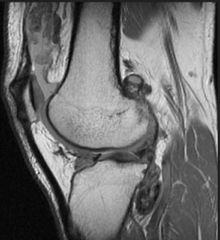
Onco 2RLJ2W6B QUESTIONS19 of 100Previous NextReview and Submit (SAE08AN.84) A 28-year-old man reports knee stiffness, swelling, and a constant ache that is worse with activity. Examination reveals an effusion, global tenderness, and warmth to the touch. Flexion is limited to 110 degrees. Figures 48a through 48d show sagittal T1-weighted, sagittal T2-weighted, axial T1-weighted fat-saturated gadolinium, and axial gradient echo MRI scans. Based on these findings, what is the most likely diagnosis? Review TopicQID: 6244FIGURES: A B C D 1Infection2Arthritis3Synovial chondromatosis4Pigmented villonodular synovitis (PVNS)5Reactive synovitis |
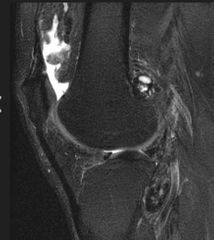
4 MRI scans show multiple low-signal intensity lesions scattered throughout the knee, extending posteriorly inferior to the tibial plateau. The low-signal intensity on both the T1- and T2-weighted images, the modest vascularity noted on the gadolinium image, and the “blooming” noted on the gradient echo image (ferrous-laden tissue) are all strongly suggestive of diffuse PVNS. Whereas synovial chondromatosis can present as diffuse masses in the knee, they present as nodule masses that have low T1- and high T2-weighted signal characteristics |
|
|
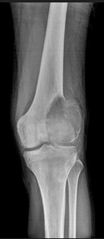
Onco 2RLJ2W6B QUESTIONS20 of 100Previous NextReview and Submit (SAE11AN.43) A 21-year-old man has had progressive knee pain and has been limping for the past several weeks. Examination reveals decreased motion, pain, swelling, and marked tenderness over the lateral aspect of the knee. An AP radiograph is shown in Figure 43. Given the radiographic appearance of the lesion, what is the most likely diagnosis? Review TopicQID: 7431FIGURES: A 1Fibrous dysplasia2Giant cell tumor of bone3Enchondroma4Osteoid osteoma5Osteochondroma |
2 radiograph shows a lytic, eccentric, expansile lesion of the distal femur that extends to the subchondral surface and has a pathologic fracture. There is no surrounding sclerosis. This is a classic appearance of a giant cell tumor of bone, and the knee is the most common presenting location. None of the other lesions listed have these same characteristics, and typically do not appear in a subchondral location. Chondroblastoma (not a choice) may have a similar appearance, and typically appears in younger patients with open physes. |
|
|
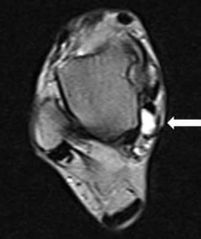
Onco 2RLJ2W6B QUESTIONS21 of 100Previous NextReview and Submit (SAE12FA.43) Figures 43a and 43b are the MRI scans of a 54-year-old woman who reports a 2-year history of progressive shooting and burning-type pain in the posteromedial ankle. What is the most appropriate management? Review TopicQID: 8065FIGURES: A B 1Needle aspiration2Tarsal tunnel release3Incisional biopsy4Surgical excision5Referral to an orthopaedic surgeon specializing in oncology |

4 MRI scans show a bright, homogeneous mass (white arrow) on the T2-weighted images consistent with a ganglion cyst, which is likely emanating from the flexor digitorum longus tendon sheath. Because of the neuritic symptoms from the tibial nerve, the patient is best managed with surgical excision. Whereas needle aspiration can provide temporary relief by mass decompression, the location of the lesion in this instance, adjacent to the tibial nerve and posterior tibial artery, makes this option less optimal. Although the cyst is deep to the flexor retinaculum, which necessitates a tarsal tunnel release to access the lesion, release of the flexor retinaculum alone will not likely provide full resolution of symptoms. Incisional biopsy is indicated for potentially malignant lesions, which also makes referral to an orthopaedic surgeon specializing in oncology in this case unnecessary. |
|
|
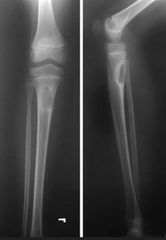
Onco 2RLJ2W6B QUESTIONS22 of 100Previous NextReview and Submit (SAE11PA.48) Figure 48 shows the AP and lateral radiographs of a 12-year-old boy with knee pain after a fall. Previous to the fall he denies any history of pain. What is the most likely diagnosis? Review TopicQID: 7532FIGURES: A 1Unicameral bone cyst2Chondroblastoma3Fibrous dysplasia4Nonossifying fibroma5Osteosarcoma |
4 patient has a nonossifying fibroma. Nonossifying fibroma is classically an eccentric, lytic lesion with a thin sclerotic border in the metaphysis. Unicameral bone cyst is typically central with variable surrounding sclerosis. Chondroblastoma is a lytic lesion in the epiphysis. Fibrous dysplasia is typically a central lytic lesion in the metaphysis or diaphysis with a ground glass appearance. Osteosarcoma is usually a mixed lytic/blastic lesion with bone destruction and formation, without sclerotic margins. |
|
|
|
Onco 2RLJ2W6B QUESTIONS23 of 100Previous NextReview and Submit (SAE12SN.55) In the treatment of chondrosarcomas of the spine and sacrum, which of the following is a significant factor associated with a worse prognosis with respect to local control and/or survival? Review TopicQID: 79681Lower histologic tumor grade of the lesion2Increasing patient age3Negative excisional margins4Initial biopsy done at the tumor center5Spine location as opposed to pelvic location of the tumor |
2 Significant factors associated with a worse prognosis with respect to local control and/or survival were high histologic tumor grade, increasing patient age, primary surgery outside of a tumor center, incisional biopsy versus a noninvasive diagnostic procedure, and inadequate surgical margins |
|
|
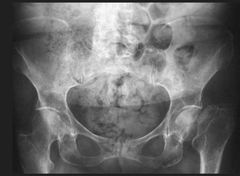
Onco 2RLJ2W6B QUESTIONS24 of 100Previous NextReview and Submit (SAE11PA.46) A 50-year-old woman with a recent diagnosis of multiple myeloma is being evaluated for left hip pain and some difficulty with ambulation. She is still receiving her initial systemic management and has extensive skeletal involvement found on her initial skeletal survey and other staging modalities. Once referred for orthopaedic evaluation, an AP radiograph of her pelvis was obtained and is shown in Figure 46. What is the most appropriate surgical option for this patient? Review TopicQID: 7530FIGURES: A 1Radical resection of the proximal third of the femur and tumor prosthetic reconstruction2Cemented hemiarthroplasty or total hip arthroplasty3Intramedullary nailing4Percutaneous screw fixation5Hip screw and side plate fixation |
2 goal of surgical management of myeloma is the same as it is for bone metastases - to relieve pain and restore function by achieving local tumor control and immediate mechanical stability. Pathologic femoral neck fractures that require surgical intervention should always be treated with removal and hemiarthroplasty or total hip arthroplasty. Bone cement augments structural stability and enables the patient to withstand the stress of immediate motion and function. Internal fixation options are less attractive because they typically do not allow immediate full weight bearing and would require the fracture to heal with the harmful effects of radiation and chemotherapy interfering with the healing process. Radical resection of the proximal femur and the tendinous attachments is not necessary for this patient and would increase the morbidity of the procedures. |
|
|
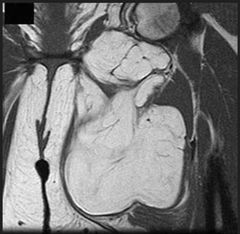
SAE08AN.38) Figures 24a through 24c show the coronal T1-weighted, T2-weighted fat-saturated, and T1-weighted fat-saturated gadolinium MRI scans of the proximal thigh of a 52-year-old woman who reports a mass in the medial thigh and groin area. She notes that the fullness has grown in size over the course of many months. Based on these findings, what is the most likely diagnosis? Review TopicQID: 6198FIGURES: A B C 1Malignant fibrous histiocytoma2Liposarcoma3Synovial cell sarcoma4Leiomyosarcoma5Clear cell sarcoma |
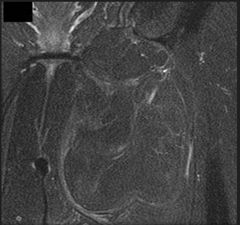
2 The images show a complex, lobular lesion of the thigh that has signal characteristics that follow fat. The size of the lesion, the areas of stranding within the mass, along with mild uptake on the gadolinium sequences and the mild edema within the lesion on the T2-weighted image make liposarcoma the most likely diagnosis and simple intramuscular lipoma far less likely. All other diagnoses listed would not follow fat characteristics shown on the MRI sequences |
|
|
|
Onco 2RLJ2W6B QUESTIONS26 of 100Previous NextReview and Submit (SAE08OS.172) A patient with known metastatic breast cancer has a lytic lesion in the subtrochanteric region of the femoral shaft. Surgical stabilization is indicated because of impending pathologic fracture. What is the recommended treatment? Review TopicQID: 65341Prosthetic replacement2Cement tumor plus flexible Enders nails3Dynamic hip screw4Standard antegrade intramedullary nail5Long cephalomedullary intramedullary nail |
5 Impending pathologic fractures of the proximal femur should be stabilized with a long cephalomedullary nail because the tumor can advance into the femoral neck and because an intramedullary device protects the rest of the femur. Prosthetic replacement is the treatment of choice when a pathologic fracture occurs through the femoral neck, since there is limited healing potential with open reduction and internal fixation. If prosthetic replacement is done, long-stem cemented implants are usually selected. Plate and screw devices and flexible nails are less satisfactory choices. |
|
|
|
SAE10PE.55) In Ewing's sarcoma, neoplastic properties are thought to be related to a Review TopicQID: 72431environmental toxins.2a prior history of osteomyelitis.3a prior history of viral illness.4a prior history of trauma.5translocation of chromosomes |
5 95% of patients with Ewing's sarcoma, there is a translocation, t(11:22). This results in EWS/FLI-1 transcription factor that results in tumor cell proliferation. Other mechanisms causing tumor cell proliferation include inactivation of tumor suppressor genes, or activation of proto-oncogenes |
|
|
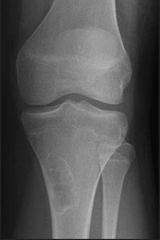
Onco 2RLJ2W6B QUESTIONS28 of 100Previous NextReview and Submit (SAE11PA.25) A 15-year-old girl is referred for evaluation of a tibial lesion noted on radiographs performed after a twisting injury of the left knee. She was asymptomatic prior to the injury that occurred 3 weeks ago. The pain from the injury has now resolved. Radiographs of the left knee are seen in Figures 25a and 25b. What is the next step in management of this patient? Review TopicQID: 7507FIGURES: A B 1CT2MRI3Bone scan4Needle biopsy5Observation |
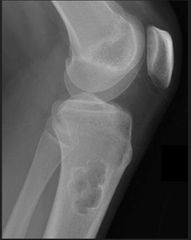
5 radiographs reveal a benign-appearing lesion of the proximal tibia metaphysis with a narrow zone of transition, an eccentric position, and a thin rim of reactive bone. The imaging characteristics are most consistent with nonossifying fibroma. These lesions may occur multiply in 8% of patients. Most lesions are eccentric with a "soap bubble" appearance and may have significant cortical thinning. Pathologic fractures may occur. This lesion was discovered as an incidental finding. Because the patient is asymptomatic, no further work-up or treatment is indicated except for observation. Most lesions resolve spontaneously by adulthood. |
|
|
|
Onco 2RLJ2W6B QUESTIONS29 of 100Previous NextReview and Submit (SAE11OS.144) Patients with multiple hereditary exostoses have a greater risk of developing what kind of mesenchymal tumor? Review TopicQID: 77321Hemangioma2Enchondroma3Chondrosarcoma4Extra-abdominal desmoid tumor5Neurofibroma |
3 Patients with multiple hereditary exostosis (MHE) have an increased risk of secondary chondrosarcomas in an area of a prior exostosis. This risk is probably 1 in 10,000 MHE patients and typically is a low-grade chondrosarcoma. Mafucci's syndrome is a different disorder and is associated with hemangiomas. Ollier's patients have multiple enchondromas. Extra-abdominal desmoids are associated with Gardner's syndrome, and von Recklinghausen's disease is associated with plexiform neurofibromas. |
|
|
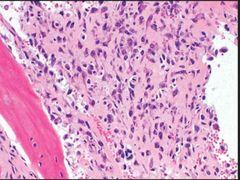
Onco 2RLJ2W6B QUESTIONS30 of 100Previous NextReview and Submit (SAE08PA.28) A 13-year-old boy has knee pain after sustaining a mild twisting injury while playing basketball 4 weeks ago. Radiographs and MRI scans are shown in Figures 24a through 24d, and biopsy specimens are shown in Figures 24e and 24f. Treatment should consist of Review TopicQID: 6289FIGURES: A B C D E F 1neoadjuvant chemotherapy followed by surgical resection and reconstruction.2chemotherapy followed by radiation therapy.3IV antibiotics for 4 weeks, followed by oral antibiotics for 4 weeks.4surgical resection and reconstruction followed by chemotherapy.5radiation therapy alone |
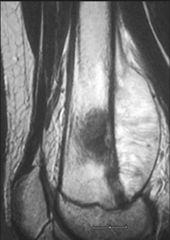
PREFERRED RESPONSE 1 The imaging studies and histology are consistent with high-grade osteosarcoma. The standard treatment for osteosarcoma is neoadjuvant chemotherapy combined with wide surgical resection that can be performed with amputation or limb salvage depending on characteristics unique to each tumor and each patient. In most patients, limb salvage surgery can be performed with reconstruction using allografts and/or megaprostheses. Osteosarcoma is poorly responsive to radiation therapy. Chemotherapy alone, in the absence of appropriate surgery, has not proven effective. |
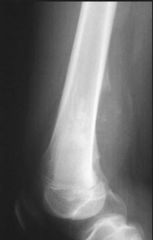
|
|
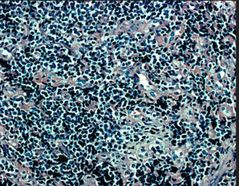
nco 2RLJ2W6B QUESTIONS31 of 100Previous NextReview and Submit (SAE08PA.70) A 19-year-old man has had pain and swelling in his left forearm for the past 8 months. Laboratory studies show a mildly elevated WBC count and erythrocyte sedimentation rate. Radiographs are shown in Figures 58a and 58b, a CT scan is shown in Figure 58c, and T1- and T2-weighted MRI scans are shown in Figures 58d and 58e, respectively. A biopsy specimen is shown in Figure 58f. Immunohistochemistry demonstrates that the lesion is negative for leukocyte common antigen (CD34). What is the most common cytogenetic translocation associated with this lesion? Review TopicQID: 6331FIGURES: A B C D E F 1(11; 22) (q24; q12)2(X; 18) (p11; q11)3(12; 22) (q13; q12)4(2; 13) (q35; q14)5(12; 16) (q13; p11) |

PREFERRED RESPONSE 1 The imaging studies show a permeative lytic destructive lesion in the proximal radius with “hair-on-end” periosteal reaction and a large soft-tissue mass most consistent with Ewing’s sarcoma. The pathology reveals monotonous sheets of “round blue” cells. This limits the differential diagnosis to primary lymphoma of bone versus Ewing’s sarcoma. These are best differentiated by immunohistochemistry, cytogenetics, and flow cytometry. Lymphoma of bone is typically CD34 positive and CD99 negative; whereas, the reverse is true of Ewing’s sarcoma, CD34 negative and CD99 positive. The most common cytogenetic translocation with Ewing’s sarcoma is 11; 22; 21; 22 and 7; 22 translocations have also been reported in Ewing’s sarcomas. The X; 18 translocation is most commonly associated with synovial cell sarcomas; the 12; 22 translocation is most commonly associated with clear cell sarcomas; the 2; 13 translocation is most commonly associated with alveolar rhabdomyosarcomas, and the 12; 16 translocation is most commonly associated with myxoid liposarcomas. Flow cytometry is used to characterize the cell types of lymphomas. PREFERRED RESPONSE 1 The imaging studies show a permeative lytic destructive lesion in the proximal radius with “hair-on-end” periosteal reaction and a large soft-tissue mass most consistent with Ewing’s sarcoma. The pathology reveals monotonous sheets of “round blue” cells. This limits the differential diagnosis to primary lymphoma of bone versus Ewing’s sarcoma. These are best differentiated by immunohistochemistry, cytogenetics, and flow cytometry. Lymphoma of bone is typically CD34 positive and CD99 negative; whereas, the reverse is true of Ewing’s sarcoma, CD34 negative and CD99 positive. The most common cytogenetic translocation with Ewing’s sarcoma is 11; 22; 21; 22 and 7; 22 translocations have also been reported in Ewing’s sarcomas. The X; 18 translocation is most commonly associated with synovial cell sarcomas; the 12; 22 translocation is most commonly associated with clear cell sarcomas; the 2; 13 translocation is most commonly associated with alveolar rhabdomyosarcomas, and the 12; 16 translocation is most commonly associated with myxoid liposarcomas. Flow cytometry is used to characterize the cell types of lymphomas. PREFERRED RESPONSE 1 The imaging studies show a permeative lytic destructive lesion in the proximal radius with “hair-on-end” periosteal reaction and a large soft-tissue mass most consistent with Ewing’s sarcoma. The pathology reveals monotonous sheets of “round blue” cells. This limits the differential diagnosis to primary lymphoma of bone versus Ewing’s sarcoma. These are best differentiated by immunohistochemistry, cytogenetics, and flow cytometry. Lymphoma of bone is typically CD34 positive and CD99 negative; whereas, the reverse is true of Ewing’s sarcoma, CD34 negative and CD99 positive. The most common cytogenetic translocation with Ewing’s sarcoma is 11; 22; 21; 22 and 7; 22 translocations have also been reported in Ewing’s sarcomas. The X; 18 translocation is most commonly associated with synovial cell sarcomas; the 12; 22 translocation is most commonly associated with clear cell sarcomas; the 2; 13 translocation is most commonly associated with alveolar rhabdomyosarcomas, and the 12; 16 translocation is most commonly associated with myxoid liposarcomas. Flow cytometry is used to characterize the cell types of lymphomas.
|

|
|
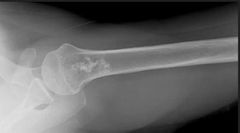
Onco 2RLJ2W6B QUESTIONS32 of 100Previous NextReview and Submit (SAE11AN.19) A 15-year-old girl injured her shoulder in a fall while riding her bicycle. She reports a mild ache over the latter aspect of the shoulder, present since the accident, but denies any prior shoulder symptoms of any kind. AP and lateral radiographs shown in Figures 19a and 19b reveal a lesion in the proximal humerus. What is the most likely diagnosis? Review TopicQID: 7407FIGURES: A B 1Osteoblastoma2Aneurysmal bone cyst3Enchondroma4Osteochondroma5Nonossifying fibroma |
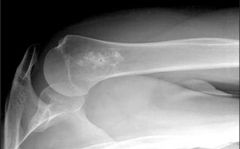
3 This scenario represents the common "serendipitous" finding of benign chondroid lesions. The radiographs demonstrate the classic "rings and arcs" calcification of an enchondroma, in a commonly presenting location (proximal humerus). The lesion is generally centrally located, and may have a well-defined lucent appearance, typically in the metaphysis of the bones. The other lesions listed do not have the typical calcification seen in these chondroid lesions. The mineral density in an osteoblastoma is more sclerotic and the lesion is often destructive. An aneurysmal bone cyst is purely lytic and generally expansile. Osteochondroma is an exophytic lesion, protruding outside the bone. Nonossifying fibroma is an eccentric, well-demarcated lesion with no mineral density. |
|
|
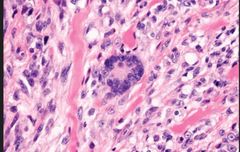
Onco 2RLJ2W6B QUESTIONS33 of 100Previous NextReview and Submit (SAE08PA.13) A 35-year-old man reports the development of a painful 2-cm nodule on his dorsal wrist over the past 3 years. A surgeon excised the lesion with a presumptive diagnosis of a ganglion cyst. Histology sections from the excision are shown in Figures 11a and 11b. What is the most likely diagnosis? Review TopicQID: 6274FIGURES: A B 1Ganglion cyst2Clear cell sarcoma3Epithelioid sarcoma4Epidermal inclusion cyst5Synovial sarcoma |
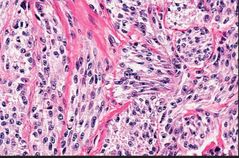
2 histologic appearance of the soft-tissue lesion reveals compact nests of cells with a clear cytoplasm surrounded by a delicate border of fibrocollagenous tissue. There can be scattered multinucleated giant cells. This is consistent with a clear cell sarcoma, also called malignant melanoma of soft parts. This tumor is usually positive for S-100 and HMB45 (a melanoma-associated antigen). These tumors are frequently found around the foot and ankle. Similar to epithelioid sarcoma, it is usually intimately bound to tendons or tendon sheaths. Often the tumors are present for many years. The classic histologic appearance of this lesion differentiates it from the other choices. |
|
|
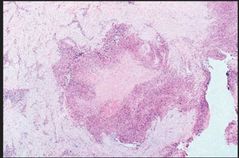
Onco 2RLJ2W6B QUESTIONS34 of 100Previous NextReview and Submit (SAE08PA.21) Figure 18a shows the clinical photograph of a 31-year-old man who has a slowly growing nodule on his right middle finger. It is minimally tender, and there is no erythema on examination. A biopsy specimen is shown in Figure 18b. What is the most likely diagnosis? Review TopicQID: 6282FIGURES: A B 1Clear cell sarcoma2Clear cell carcinoma3Epidermal inclusion cyst4Nora’s tumor (BPOP)5Epithelioid sarcoma |

5 Epithelioid sarcoma is the most common soft-tissue sarcoma in the hand and most commonly occurs in young adults. The tumors can be superficial and may become ulcerated. Deeper lesions are often attached to tendons, tendon sheaths, or fascial structures. These are usually minimally symptomatic. The biopsy specimen reveals the typical appearance of a nodular pattern with central necrosis. They can mimic a necrotizing granulomatous process. Usually there are chronic inflammatory cells along the margin of the tumor nodules. This biopsy specimen does not have the clear cells necessary for a clear cell carcinoma or sarcoma. Nora’s tumor is a bizarre parosteal osteochondromatous proliferation (BPOP) first described in 1983 by the pathologist, Nora. The lesion is defined as a reactive heterotopic ossification and is mostly found in the hands or feet of adults in the third decade of life |
|
|
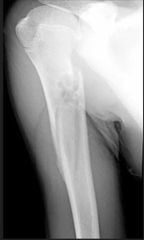
Onco 2RLJ2W6B QUESTIONS35 of 100Previous NextReview and Submit (SAE11PA.8) An otherwise healthy 15-year-old boy is seen in the emergency department for an injury sustained while playing dodge ball. A radiograph is shown in Figure 8. What is the most appropriate treatment for this patient? Review TopicQID: 7567FIGURES: A 1Aspiration and injection2Resection and reconstruction3Sling and pain medication4Curettage and bone grafting5Intramedullary nail fixation |
3 patient has a pathologic fracture through a benign-appearing eccentric bone lesion with a soap-bubble geographic appearance, most suggestive of a nonossifying fibroma. The best initial treatment is to provide comfort measures and allow the fracture to heal. Aspiration and steroid injection has been advocated for a unicameral bone cyst, though it should be done after any associated fracture has been allowed to heal. Wide resection is not indicated for this benign tumor Extended curettage and grafting may be appropriate, but only after fracture healing has occurred unless open reduction and internal fixation is indicated for the fracture itself. Intramedullary nail fixation is unnecessary and generally should not be performed if the histopathologic diagnosis is not known. |
|

